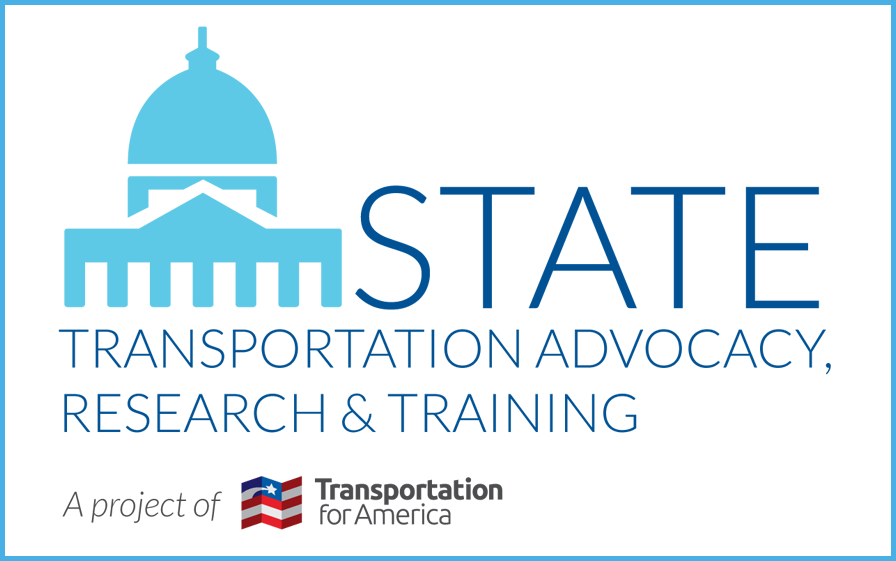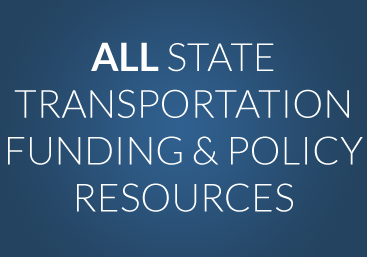Browse the report
POLICY GOALS
- I: Increase accountability and transparency to build taxpayer confidence
- II: Make states economically competitive; empower locals to do the same
- III: Invest in innovation and reward the smartest projects
- IV: Maximize savings through better project development
- V: Improve safety through better street design
Download the full report (pdf)
Join the START Network
T4America supports efforts to produce and pass state legislation to increase transportation funding, advance innovation and policy reform, empower local leaders and ensure accountability and transparency. Join the network.
State policy & funding home
Click here to visit our central hub for all state policy and funding resources, including our work tracking proposals in states to raise new transportation funding or reform the policies governing those funds to improve how those dollars are spent.
Stay informed
Sign up to receive news and updates from T4America. All fields are required.
Goal I: Increase accountability and transparency to build taxpayer confidence
OVERVIEW
Transportation funds are stretched at all levels of government, forcing transportation stakeholders to go ‘hat in hand’ to ask elected officials to raise revenue or cut other programs in order to provide more dollars for aging transportation systems.
Rightfully so, legislators and taxpayers want to know what they get for their current investment, let alone whether any new funds would be spent wisely in helping their commutes, their pocketbooks, the larger economy and their community’s quality of life. Unfortunately, most transportation agencies rarely spend any time answering those bigger questions from the public, and instead focus on advancing specific transportation projects as an end unto itself, ultimately failing to make a compelling case to their ultimate customers: the taxpayers.
And taxpayers (and legislators) may respond with general skepticism about the need for more money to invest in transportation.
Further compounding that rightful skepticism is the ways in which many state DOTs decide how their scarce resources will be invested. When reviewing the lists of projects states hope to fund and build (a list typically known as the State Transportation Improvement Program), transportation experts and residents alike often can’t ascertain why a project is receiving funds, why other projects didn’t ‘make the cut’, or how any given project will help achieve broader, measurable goals for the state like improving access to jobs and strengthening the economy.

These projects on Arkansas’ STIP are selected to receive funding for construction. Can anyone tell from this page why the Cash Bypass deserves $55 million in taxpayer funds? Important though it may be, the lack of a project description or the expected benefits received from this large investment would lead any taxpayer to question Cash Bypass’ return-on-investment benefit. From the Arkansas FY 2013-2016 STIP, page 97. https://www.arkansashighways.com/stip/2013-2016/STIP_2013_2016_final.pdf.
The opaque process that most states use to plan their transportation investments leads many taxpayers to believe that their transportation investments are based on politics rather than merit, providing little credibility for legislators and state DOTs to ask taxpayers to pay more for transportation investments.
PROPOSAL #1
IMPROVE ACCOUNTABILITY BY MEASURING PERFORMANCE
There are powerful examples of states that are changing this opaque process by instituting a focus on performance and accountability in order to provide greater certainty that projects are selected based on merit and meaningful outcomes rather than politics. Providing more certainty and increasing accountability and transparency in the process help to build taxpayer confidence, which is crucial for any effort to raise future revenue for transportation.
Virginia, with HB 2 of 2014, and Massachusetts with H3535 in 2013, have led the charge to reform their processes to a performance based project selection process, and their efforts are a useful road map for other states hoping to do the same.
Under Virginia’s HB 2, all capital construction and capacity projects will be measured against the state’s priorities, specified by the legislature, which include safety, congestion mitigation, accessibility, environmental quality, economic development, and land use — rather than political whims. The scoring is made public and transparent, giving taxpayers a way to see how and why projects were selected.
As part of a 2013 deal to raise new revenue for transportation, the Massachusetts legislature required the DOT to develop and use performance-based criteria in the state’s transportation investment decisions. The criteria Massachusetts is now using to measure anticipated outcomes for transportation projects include eight broad policy priorities: 1) system preservation; 2) mobility; 3) cost effectiveness; 4) economic impact; 5) safety; 6) social equity and fairness; 7) environmental and health effects; and 8) local and regional policy support.
Virginia has just released its first project prioritization list based on the performance measures, and Massachusetts is working to finalize its measures. Many other states are either taking initial steps of their own or looking to follow Virginia’s and Massachusetts’ lead, including Louisiana, Maryland, Michigan, Minnesota and Oregon.
PROPOSAL #2
MEASURE PROJECT OUTCOMES IMPORTANT TO TAXPAYERS
In many jurisdictions, success is too narrowly measured and defined, resulting in solutions designed for a singular location with limited concern for the entire system’s benefit. It’s important to take a broader view of what constitutes success and how it’s measured.
The area measured most consistently throughout the history of the transportation program is traffic flow.
Using level of service (LOS) standards, transportation engineers measure current and projected conditions for vehicles, and use those ratings to define the scope or design of a project. Because this limited measure accounts only for the movement of vehicles, in the case of roads and intersections with vehicle delay exceeding engineering standards, it requires transportation agencies to expand roads as a one-size-fits-all solution. As a result, other solutions are ignored, infill development to make use of existing infrastructure is discouraged, and the benefits of building infrastructure for public transportation, bicycles and pedestrians are neglected.
California’s DOT, advocates and elected officials have long cited these level of service standards as inadequate and far too narrow for making necessary multimodal transportation decisions. The state uses LOS standards for environmental quality assessments for transportation projects. An unintended consequence of using LOS for these environmental assessments is that roads determined to have excessive vehicle delay require expensive capacity expansions for new development, which negatively impact the environment, public health and the bottom line.
In 2013, the state legislature passed SB 743, requiring the state Office of Planning and Research to develop an alternative to LOS standard requirements for environmental assessments for transportation projects. The new alternative must “promote the reduction of greenhouse gas emissions, the development of multimodal transportation networks, and a diversity of land uses” for areas served with public transportation. The Office of Planning and Research is currently reviewing planning processes to remove LOS standards and is working with stakeholders to develop alternative measures to improve transportation project development for multimodal solutions, and may include vehicle miles traveled, vehicle miles traveled per capita, automobile trip generation rates or automobile trips generated.








